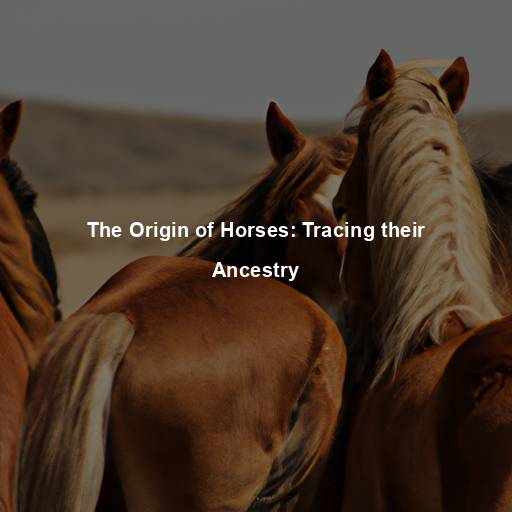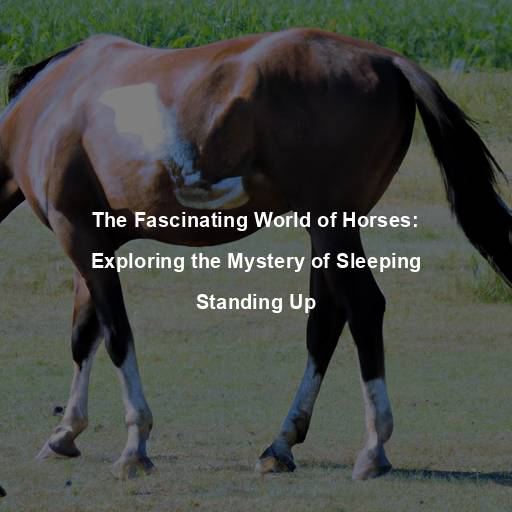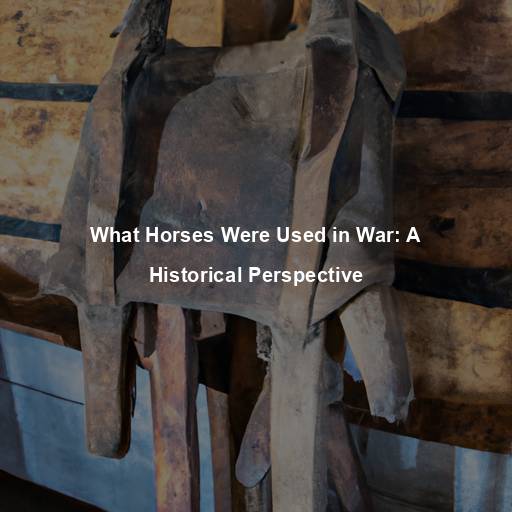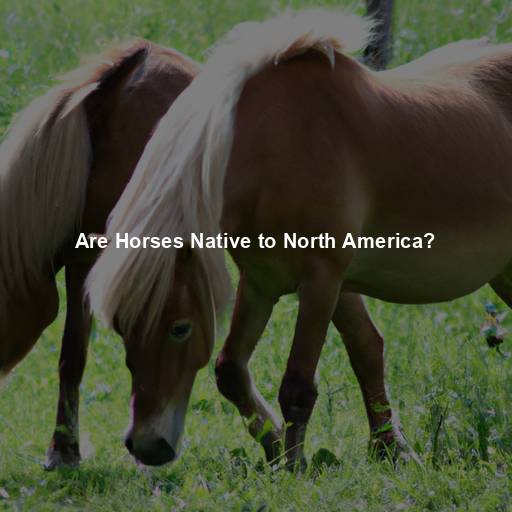The Origin of Horses: Tracing their Ancestry
Last Updated on November 6, 2023 by Evan
Contents [hide]
- 1 Unraveling the Mysteries of Horse Origins
- 2 Preserving the Legacy
- 3 The Fascinating World of Horse Breeds
- 4 The Future of Horses: Nurturing the Bond
- 5 FAQs – Where are horses originally from?
- 5.1 Q: Where are horses originally from?
- 5.2 Q: How did horses spread to other parts of the world?
- 5.3 Q: When were horses first domesticated?
- 5.4 Q: Did horses ever become extinct in their native region?
- 5.5 Q: When were horses reintroduced to North America?
- 5.6 Q: Are there any wild horses left in North America?
- 5.7 Q: What impact did horses have on human civilization?
- 5.8 Q: Are there any horse species unique to specific regions?
Unraveling the Mysteries of Horse Origins
Horses have captivated the hearts and minds of humans for centuries. These majestic creatures, with their graceful movement and powerful presence, have played a significant role in shaping human history. But have you ever wondered where horses originally came from? Join us on a journey through time as we unravel the mysteries surrounding the origins of these remarkable animals.
A Glimpse into Ancient History
Journey with us back to the ancient folds of time, where the enigmatic beginnings of the majestic equine world lie shrouded in mystery. It was an epoch that witnessed the captivating emergence of eohippus, a captivating creature aptly named the “dawn horse”. Contrary to the grandeur of modern horses, these diminutive beings stood at a mere foot tall, traversing a world with tiny toes instead of the iconic hooves we know today. Delve into the depths of this captivating evolution, where the enigma of equine ancestry continues to perplex and captivate.
The Evolutionary Path
Over the course of millions of years, the descendants of the eohippus underwent significant evolutionary changes. Through a process known as natural selection, these ancient horses adapted to their changing environment, gradually transforming into the magnificent creatures we know today.
From Forests to Plains
Throughout the ages, nature’s enigmatic touch guided the path of horses, leading them through an astonishing transformation. As the rhythmic dance of climate took center stage, lush forests transformed into vast grasslands, posing a formidable challenge to these majestic creatures. In a mesmerizing twist of fate, horses defied the odds, their very existence a testament to their remarkable adaptability. Witness their sublime evolution as their once compact frames stretched skywards, their dainty teeth shaped into formidable instruments for harvesting the abundant green tapestry, and their legs elongated into slender pillars, propelling them with grace through a wilderness teeming with predators.
A Single-Toed Success Story
One of the most remarkable transformations in horse evolution was the development of a single toe or hoof, replacing the multiple toes of their early ancestors. This adaptation enhanced their speed and agility, allowing them to cover vast distances with ease. The emergence of the modern horse, equipped with a single toe, was a pivotal moment in their evolutionary journey.
Tracing Genetic Footprints
While the physical evolution of horses provides us with valuable insights, genetic research has also played a crucial role in unraveling their origins. By studying the DNA of various horse breeds, scientists have been able to trace their ancestry back to a common ancestor.
The Przewalski’s Horse
In the vast realm of horse genetics, a fascinating revelation resonates with bewildering force – the remarkable identification of the Przewalski’s horse as our immediate link to the primordial foundations of all contemporary equine breeds. These enigmatic creatures, teetering on the brink of extinction, effortlessly embody a compelling thread that tethers them to the ancient horses that once roamed the vast steppes of Central Asia. In this perplexing backdrop, the discovery of their shared genetic lineage unveils a mesmerizing tapestry woven by the hands of time, hinting at a world shrouded in far-reaching connections and vivid ancestral narratives.
The Steppes of Central Asia: Cradle of Horse Domestication
While the origins of horses can be traced back to the forests of North America, it is in the vast steppes of Central Asia that the story of horse domestication unfolds. The nomadic tribes that roamed these grasslands recognized the potential of horses as loyal companions and invaluable assets in their way of life.
The Bond Between Humans and Horses
Throughout the annals of time, there exists a pivotal moment that forever altered the course of human existence – the enchanting saga of horses tamed by noble hands. These majestic beings, harnessed with determination, unfolded an extraordinary tapestry of intertwined destinies; ploughing fields in harmonious unity, galloping across vast terrains as tireless steeds, and charging into the crucible of war as fearless comrades. As the eons passed, an unbreakable kinship between kindred spirits weaved an intricate web, birthing an array of remarkable horse breeds, each delicately crafted to fulfill distinct desires and aspirations.
From the Steppes to the World
The awe-inspiring journey of the equine conquerors commenced in the heart of Central Asia, unlocking an enigmatic tale of transformation that would reverberate across every inch of our astonishing planet. As human civilizations thrived and mingled, these majestic creatures took on a profound purpose, bridging the gap between distant souls and facilitating the exchange of priceless knowledge and goods. Galloping fearlessly through uncharted realms, they carried tales of exploration and curiosity, painting the tapestry of our history with vibrant hues of discovery and wonder. From the dramatic rise of empires to the heartbreaking descent of once-mighty realms, these ethereal stallions stood as both witnesses and catalysts to the continuous ebb and flow of human existence.
Horses in Warfare
Throughout history, horses played a significant role in warfare. From the chariots of ancient civilizations to the cavalry of medieval knights, these noble creatures carried warriors into battle, instilling fear in their enemies and turning the tide of conflicts. Their strength, speed, and unwavering loyalty made them indispensable assets on the battlefield.
The Horse’s Journey Across Continents
Throughout the ages, the wild and untamable spirit of horses has weaved its way across continents, leaving in its wake a trail of awe and marvel. Originating in the wide expanse of Central Asia’s sprawling steppes, these majestic creatures embarked on an epic journey that transcended geographical boundaries. Guided by migrating tribes, intrepid traders, and bold explorers, horses gallantly trotted their way into the heart of Europe, the vast landscapes of Africa, and even ventured off to the enigmatic Americas. From ancient rituals and profound connections to the pivotal role they played in shaping cultures, economies, and the very tapestry of human history, the impact of these marvelous equines is truly extraordinary.
Preserving the Legacy
The majestic presence of horses has transcended time, captivating countless souls worldwide. Whether it be through the exhilarating realm of equestrian sports or the therapeutic embrace they offer in specialized programs, these magnificent beings hold an inexplicable power over us. Nevertheless, we must confront the stark realities they confront in our ever-evolving world – the erasure of their natural habitats, the relentless cycle of overbreeding, and the tragic shadow of neglect that looms over their existence.
As we celebrate the rich history and incredible journey of horses, let us also recognize our responsibility to protect and preserve their legacy for future generations. By supporting conservation efforts, promoting responsible breeding practices, and advocating for their welfare, we can ensure that horses continue to inspire and enrich our lives for years to come.
Horses as Companions and Sporting Partners
Horses have long been cherished as companions and sporting partners. The bond between humans and horses goes beyond practical uses; it is based on mutual trust, respect, and a shared love for these magnificent creatures. Equestrian sports, such as show jumping, dressage, and rodeo events, showcase the unique partnership between horse and rider, highlighting the incredible athleticism and grace of both.
Horses in Agriculture and Transportation
Throughout history, the magnificent and enigmatic creatures we now know as horses have played an incomparable role in shaping our world. From the humble beginnings of their domestication, these majestic beings burst forth with boundless strength and unparalleled grace. Seamlessly integrating into the fabric of human existence, horses transformed the agricultural landscape, reshaping the very foundations of farming practices. Their undeniable power propelled carts and carriages, transporting goods and dreams along vast networks of connectivity.
The Symbolism of Horses in Art and Literature
Throughout centuries, horses have stood as captivating symbols in various art forms, literature, and folklore worldwide. Their mesmerizing blend of elegance, resilience, and untamed spirit has enraptured the creative minds of countless artists and writers throughout the ages. From the awe-inspiring cave paintings of antiquity to the masterpieces of renowned literary geniuses, such as “Black Beauty” and “War Horse,” these majestic creatures have been celebrated as embodiments of freedom, nobility, and unwavering tenacity.
Horses in Warfare and Communication
The role of horses in warfare cannot be overlooked. Throughout history, mounted warriors and cavalry units relied on horses for their speed, maneuverability, and height advantage on the battlefield. From the Mongol Empire’s fearsome cavalry to the iconic knights of medieval Europe, horses played a crucial role in shaping the outcomes of conflicts. They facilitated communication and swift movement across vast territories, enabling the transmission of messages and the coordination of military strategies.
Equine-Assisted Therapy and Rehabilitation
Over the past few years, there has been a profound recognition of the therapeutic prowess of our equine companions. As a result, innovative programs that utilize horses for therapy and rehabilitation have blossomed, catering to the diverse needs of individuals facing physical, cognitive, and emotional challenges. The profound impact of these majestic creatures on mental well-being cannot be overstated, as their gentle presence and the immersive experience of riding unfold a world of improved confidence, enhanced communication skills, and an overall elevation in the quality of life.
The Conservation of Horse Breeds
In the ever-evolving world of equine preservation, the utmost urgency lies in safeguarding the genetic tapestry that weaves together the intricate resilience and adaptability of horse breeds. With fervent dedication and unyielding spirit, tireless endeavors are being undertaken to protect the rare and endangered lineages from the precipice of oblivion. A symphony of breeding programs, genetic research, and public awareness campaigns harmoniously dance in unison, aiming to preserve these remarkable equine legacies for posterity. As the future unfolds with perplexing twists and unforeseen turns, our collective commitment remains resolute in ensuring that the rich heritage of these majestic creatures endures the test of time.
The Fascinating World of Horse Breeds
Explore the enchanting realm of horse breeds, where a symphony of diversity and uniqueness unfolds. From majestic thoroughbreds with their graceful strides, to sturdy draft horses that embody strength and power, the tapestry of equine variety is nothing short of awe-inspiring. Journey with us as we unravel the intriguing enigma of horse breeds, delving into their distinctive characteristics, resplendent appearances, and extraordinary abilities that have captivated humanity for centuries. It’s time to unveil the treasures hidden within the equestrian landscape and discover the wonders that await in this remarkable equine mosaic.
Thoroughbred: The Speed Demons
From their origins in 17th century England to their present-day fame as the superstars of horse racing, Thoroughbreds have captivated generations with their unmatched speed and agility. These magnificent creatures have been meticulously bred over time, their genetics intricately engineered to create the perfect racing machine. With their streamlined physiques, elegant long legs, and formidable muscles, Thoroughbreds symbolize the pure essence of speed and the thrill of breathtaking competition.
Arabian: The Graceful Beauties
Arabian horses are celebrated for their elegance, endurance, and distinctive dished faces. Originating from the Arabian Peninsula, they are one of the oldest and most influential horse breeds in the world. Arabian horses have a long history of being treasured by Bedouin tribes for their loyalty, resilience, and ability to thrive in harsh desert environments.
Quarter Horse: The Versatile All-Rounders
Discover the captivating allure of the Quarter Horse, an American treasure that boasts an impressive blend of power, agility, and adaptability. This magnificent breed shines brilliantly in the realm of short-distance racing, while effortlessly conquering the demanding tasks of ranch work and Western riding disciplines. Exuding an aura of strength with their robust physique, coupled with a serene disposition, these exceptional equines reign supreme in the realm of versatility, leaving horse enthusiasts spellbound and longing for more.
Friesian: The Majestic Powerhouses
Originating from the picturesque Netherlands, the renowned Friesian horses encompass a captivating allure that leaves spectators in awe. With their lustrous ebony coats, cascading manes, and gracefully feathered legs, these majestic equines exude both elegance and strength. Sought-after in the realms of dressage and driving, Friesians mesmerize onlookers through their hypnotic, high-stepping gaits and an unmistakable royal aura that permeates their every stride.
Andalusian: The Spanish Elegance
Originating in the Iberian Peninsula, Andalusians are admired for their grace, beauty, and exceptional dressage abilities. With their strong build, arched necks, and expressive eyes, these horses embody elegance and sophistication. Andalusians have a rich history in classical riding and have been favored by royalty throughout the ages.
Mustang: The Wild Spirits
Mustangs, the descendants of domesticated horses that returned to the wild, hold a special place in the hearts of horse enthusiasts. Roaming freely across the American West, these horses embody the untamed spirit of their ancestors. Mustangs are known for their hardiness, intelligence, and remarkable adaptability to harsh environments.
The Future of Horses: Nurturing the Bond
As we look to the future, it is paramount that we continue to nurture and protect the bond between humans and horses. Advocating for responsible horse ownership, supporting equine welfare organizations, and promoting sustainable breeding practices are essential steps towards ensuring the well-being of these extraordinary creatures.
Education and public consciousness have proven to be vital factors in nurturing a profound comprehension of horses and their requirements. Encouraging the dissemination of information concerning adequate care, effective training methodologies, and the preservation of horse environments serves to empower both present and upcoming cohorts, fostering a sense of empathy and responsibility towards these extraordinary creatures.
Throughout the annals of time, horses have etched their indelible mark upon the tapestry of human existence. From their enigmatic origins to their multifaceted roles within society, they have both captivated and perplexed us. As we embark on a journey to commemorate the extraordinary legacy of these majestic creatures, let us not only appreciate, but also safeguard their awe-inspiring presence that has intertwined with our individual and collective destinies.
FAQs – Where are horses originally from?
Q: Where are horses originally from?
Did you know that horses, those majestic creatures we see galloping in fields and racing on tracks, actually have their origins in North America? It’s quite fascinating to think that these graceful animals can be traced back around 50 million years to a tiny creature called Eohippus, also known as the “dawn horse,” which once roamed the lush forests of North America. The transformation from a small dog-sized creature to the magnificent horses we know today is a journey full of wonder and evolution. Truly a testament to the burst of life and perplexity that nature offers.
Q: How did horses spread to other parts of the world?
Burst into the captivating journey of horses as they traversed the globe, propelled by a whirlwind of natural migration and intertwined with human intervention. During the enigmatic Ice Age, those majestic creatures defied daunting odds, venturing across land bridges that emerged with lowered sea levels, galloping from North America to Asia and Europe. Like enigmatic envoys, these noble steeds shaped their destiny, captivated by evolving human civilizations that domesticated and meticulously bred them for countless purposes. As the world unfolded its mysteries, horses propelled themselves across continents, entangled in the delicate dance of trade, exploration, and conquest.
Q: When were horses first domesticated?
A: Horses were first domesticated around 4000-3500 BC by the people of the Eurasian Steppe, a vast region stretching from Hungary to China. This population of people, known as the Botai culture, were among the earliest known horse breeders and riders in history.
Q: Did horses ever become extinct in their native region?
A: It’s a perplexing tale indeed. Once upon a time, in the vast stretches of North America, the majestic horses roamed free. But oh, how things took a turn! As the chilly grip of the last Ice Age began to loosen its hold, these magnificent creatures vanished from the very land they once called home. Why, you might ask? Alas, the answers elude us – lost in the annals of time. Some say it was the capricious dance of the ever-changing climate, while others suggest the heavy hand of early human hunters. The truth, it seems, is as ethereal as the fading hoofprints in the sand.
Q: When were horses reintroduced to North America?
B: The resplendent return of the equine majesty to the vast expanse of North America came as a consequence of valiant European adventurers who dared to conquer uncharted horizons. Like a symphony of hooves thundering across the annals of time, Christopher Columbus and his courageous comrades played a pivotal role in this equestrian odyssey, as they unveiled the bewitching sight of horses trotting on newfound territories. It was a moment of profound revelation, as the ancient bond between horse and land was reignited, bridging the chasm of millennia’s absence with perplexing grace.
Q: Are there any wild horses left in North America?
Absolutely! Believe it or not, the majestic and untamed spirit of wild horses still roams free in the vast landscapes of North America. Among these untethered creatures, the iconic Mustangs reign supreme, captivating the hearts of all who dare to witness their astonishing existence. With roots tracing back to their domesticated ancestors, these wild horses embody the epitome of freedom as they gallop, unburdened and unrestrained, across the expansive territories carefully overseen by the Bureau of Land Management.
Q: What impact did horses have on human civilization?
A: The domestication and use of horses had a profound impact on human civilization. Horses revolutionized transportation, agriculture, warfare, and trade. They became essential for long-distance travel, enabling the establishment of trade routes and the exchange of goods and ideas. In warfare, horses provided increased mobility and power, shaping the outcomes of countless battles throughout history. Additionally, horses were vital in agricultural practices, transforming farming efficiency and productivity.
Q: Are there any horse species unique to specific regions?
A: Yes, different regions have horse breeds that are unique to their specific environments. For example, the Arabian horse is known for its origin in the Arabian Peninsula and is recognized for its endurance and elegance. The Icelandic horse, developed in Iceland, is adapted to extreme weather conditions and displays additional gaits not seen in other horse breeds. These regional variations in horse breeds have evolved over time due to the influence of local climates, landscapes, and cultural preferences.







